
These 6 slides include descriptions of, photos of, formative assessment for, and extension reading for 4 water 'clean-up' strategies. These strategies are: fountain or bubbler oxygenation, wood chip bioreactors, reverse osmosis, and ion exchange resins.
I use it with water quality testing activities, and data analysis activities to meet standard:
HS LS 2-7: Design, evaluate, and refine a solution for reducing the impacts of human activities on the environment and biodiversity.
HS LS 2-2: Use mathematical representations to support and revise explanations based on evidence about factors affecting biodiversity and populations in ecosystems of different scales.
HS LS 2-1: Use mathematical and/or computational representations to support explanations of factors that affect carrying capacity of ecosystems at different scales.
Standards about materials cycling in the environment can also be supported using the Nitrogen Cycle.
- Subject:
- Biology
- Ecology
- Hydrology
- Life Science
- Physical Science
- Material Type:
- Reading
- Author:
- Ryan Richardson
- Date Added:
- 08/25/2020
